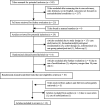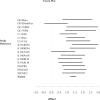The effectiveness of thoracic spine manipulation for the management of musculoskeletal conditions: a systematic review and meta-analysis of randomized clinical trials
- PMID: 20140155
- PMCID: PMC2813505
- DOI: 10.1179/106698109791352085
The effectiveness of thoracic spine manipulation for the management of musculoskeletal conditions: a systematic review and meta-analysis of randomized clinical trials
Abstract
Thoracic spine manipulation (TSM) is an intervention practiced by different professions, and recently an incursion of research using TSM has been published. The purpose of this review was to examine the effectiveness of TSM for the management of musculoskeletal conditions and the quality of trials that included TSM techniques. A comprehensive search of online databases was performed, and first authors of studies identified were contacted. Thirteen randomized clinical trials were included in the final review. The methodological quality of all studies was assessed using the 10-point PEDro scale. Seven of the 13 studies were of high quality. Three studies looked at TSM for treatment of shoulder conditions; however, there is limited evidence to support the use of TSM for shoulder conditions. Nine studies used TSM for the management of neck conditions. The meta-analysis identified a subset of homogeneous studies evaluating neck pain. The value of the pooled estimator (1.33) was statistically significant for the treatment effect of TSM in the studies with researcher effect removed (95 % confidence interval: 1.15, 1.52). This analysis suggests there is sufficient evidence to support the use of TSM for specific subgroups of patients with neck conditions. This review also identifies the need for further studies to examine the effectiveness of TSM to treat shoulder conditions and the effectiveness of TSM on neck conditions with long-term follow-up studies.
Keywords: Meta-Analysis; Shoulder; Spinal Manipulation; Systematic Review; Thoracic Spine.
Figures



References
-
- Adams G, Sim J. A survey of UK manual therapists' practice of and attitudes toward manipulation and its complications. Physio-ther Res Int. 1998;3:206–227. - PubMed
-
- American Physical Therapy Association Guide to Physical Therapist Practice. Phys Ther. 2001;81:9–746. 2nd ed. - PubMed
-
- Aspegren D, Hyde T, Miller M. Conservative treatment of a female collegiate volleyball player with costochondritis. J Manipulative Physiol Ther. 2007;30:321–325. - PubMed
-
- Bergman GJD, Winters JC, Groenier KH, et al. Manipulative therapy in addition to usual medical care for patients with shoulder dysfunction and pain. Ann Intern Med. 2004;141:432–439. - PubMed
-
- Boyles RE, Ritland BM, Miracle BM, et al. The short-term effects of thoracic spine thrust manipulation on patients with shoulder impingement syndrome. Man Ther. 2009;14:375–380. - PubMed
LinkOut - more resources
Full Text Sources
Medical
